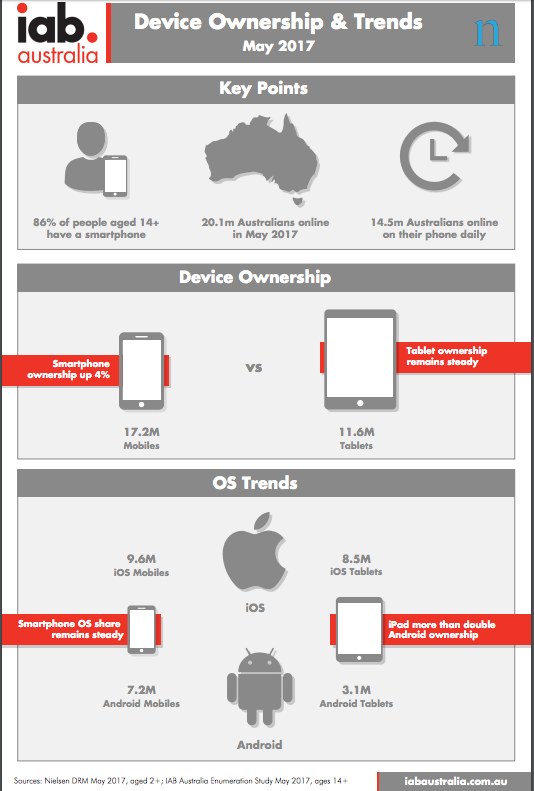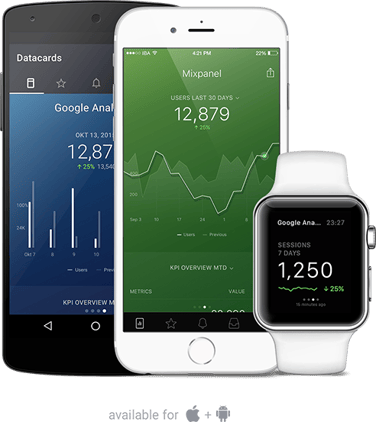Mobile phone usage around the world is growing phenomenally. 14.5m Australians are online on their phones daily! People use their mobiles for a variety of activities including social networking, job-hunting and reviewing educational content.
As the use of mobiles grow in today's cluttered tech environment, how do you get your brand to stand out from the crowd?
Australia’s smartphone penetration level sits at 84% — the fourth largest market globally after Norway (91%), South Korea (89%), and the Netherlands (87%), the 2016 Deloitte Mobile Consumer Survey revealed.
As part of IAB Australia’s role in managing the digital audience measurement currency endorsement process, it is vital that there is continual tracking of macro digital device ownership and usage trends to ensure that our measurement systems are built to reflect the Australian population.

The IAB Measurement Council, which comprises representatives from 20 different commercial organisations, reviews and assesses enumeration and currency data every month to ensure the currency continues to evolve and reflect consumer media usage habits.
This clearly shows that the use of mobile phones is on the rise and that the growth will continue to trend upwards. Mobile marketing should be top priority for marketers.
1. Focus on creating an omnichannel user experience
As marketers, delivering the right experience at the right time will define success in many ways. Here are the key elements to consider:
- Users’ most important and common tasks: why people engage with the business
- When and where they complete these tasks: the typical setting, environment, and point in time
- What devices and channels they use to complete these tasks at different stages of the customer journey, as well as the most common tasks on each of these channels
- The strengths of each device and channel and the most common context of use for each of them
It's important to associate users and their tasks and map that to devices or channels. To overcome the changing device challenge, businesses lean toward using responsive web design.
Responsive design is a development technique that detects the client type and dynamically adjusts the layout of a site according to the size of the screen on which it is displayed. Thus, the same content may be displayed in a three-column format on a desktop, two-column format on a tablet, and one-column format on a smartphone.
We use the powerful HubSpot COS to create websites that are responsive. So no matter what device you're on, we've got you covered to have a painless user experience.
2. Use a Mobile-First Approach to web design
Web design has always focused on creating websites that look great on desktops. As the economy continues to change it's vital that brands adapt to creating mobile-first user experiences.
Designing for mobile first not only prepares you for the explosive growth and opportunities in this space, it forces you to focus and enables you to innovate.
Luke Wroblewski spoke at Conversions @Google 2017 about designing for mobile. In today's world, not all screens are equal, and Luke talks about the key themes you need to remember when designing your website.
We talk about growth-driven design all the time and love it, but we're also going to put our mobile-first approach to the test and see if we can create more websites that are engage and convert.
An Erickson research said that experiencing delays on mobile causes levels of stress higher than horror movies!3. Keep track of important metrics on the go
Australians use mobile phones on the go and marketers on the go could really make the most of using tools that quickly and succinctly outline how they're doing and make some decisions on the go. There are many tools to increase your productivityas a marketer.
Databox has nailed the psychology behind mobile behaviour where visual clarity helps processing. If an interface is easy to understand, people are more likely to experience pleasure with it. This leads to higher purchasing intent & repeat experiences.

So it's time to get the mobile-first KPI Dashboard. Time to create an experience for yourself as a marketer to make decisions on metrics that are most important to your business and make it all a lot less boring.
As users move from one device to another in their everyday lives, it will remain very important for every marketer to focus on the importance of making their brand and website look fantastic on a little screen. The mobile-first approach is definitely here to stay.
Tags:
Marketing + Automation
July 14, 2017

